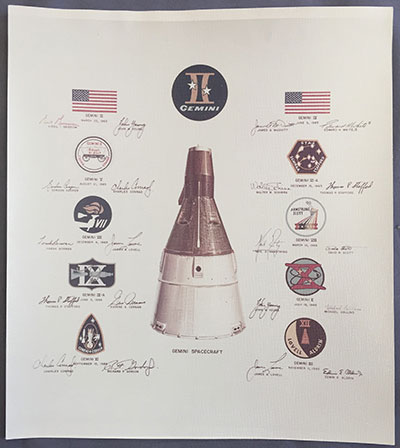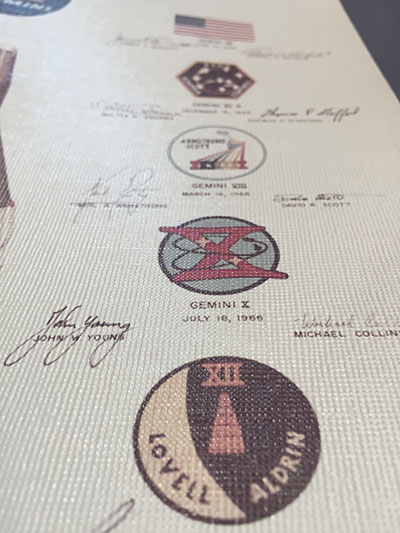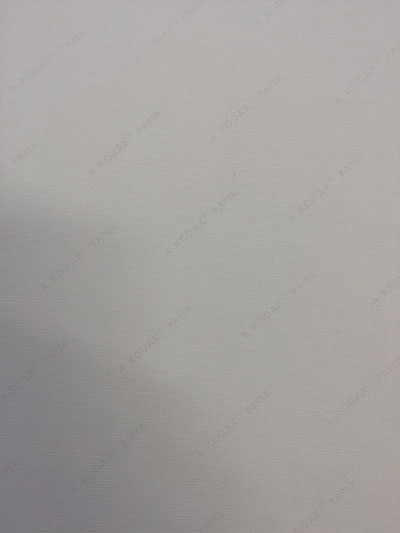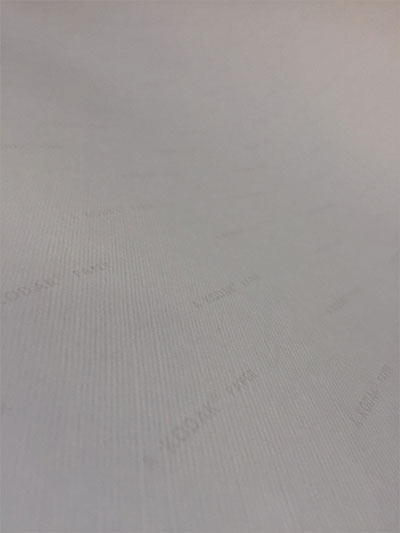|
Author
|
Topic: A Kodak Paper canvas-type Apollo prints
|
Chuckster01
Member Posts: 900
From: Orlando, FL
Registered: Jan 2014
|
 posted 02-22-2020 06:22 PM
posted 02-22-2020 06:22 PM
   
The American Space Museum just received a consignment of Apollo era red numbers photographs for an upcoming auction.In this consignment are several 16" x 20" Apollo photographs all marked A Kodak Paper on the back but these look and feel like canvas. They are textured and might even be mistaken for heavy wallpaper if they were blank. I have not encountered the textured canvas-type prints with the normal A Kodak Paper water marks on the back so I was wondering if anyone else knows the story of this paper. |
Chuckster01
Member Posts: 900
From: Orlando, FL
Registered: Jan 2014
|
 posted 02-24-2020 05:10 AM
posted 02-24-2020 05:10 AM
   
I thought maybe a few pictures might help. This is a photograph of the Gemini crew signed lithograph. Again I am not sure how well the A Kodak paper will show in the photos as the watermarks are fairly light. I hope this starts the discussion.  


|
CJ
Member Posts: 42
From: Cherry Hill, NJ
Registered: Nov 2003
|
 posted 02-24-2020 07:42 PM
posted 02-24-2020 07:42 PM
   
The "A Kodak Paper" logo on the back was used by Kodak in the 60's and early 70's on the back of their color papers. My guess is that the paper was run through a texturing machine that added the canvas look and feel. This would account for the texture on the back of the paper as well as the front. |
dwager
Member Posts: 62
From: Augusta, GA
Registered: Sep 2014
|
 posted 02-24-2020 08:21 PM
posted 02-24-2020 08:21 PM
   
Chuck - I have this same finish on an Apollo 11 red serial numbered photo of Aldrin saluting the flag. I always assumed it was an "old school" matte finish. I wouldn't mind being corrected if I received a correct understanding of this finish. There are no old photo shops in the area any longer, or else I would take it to someone and ask... |
Chuckster01
Member Posts: 900
From: Orlando, FL
Registered: Jan 2014
|
 posted 02-25-2020 04:28 AM
posted 02-25-2020 04:28 AM
   
David, I have a set of nine Apollo 11 shots all 16" x 20" in this textured paper in the consignment. They're beautiful.I had an e-mail by a person who suggested this paper was for high-end photographic portraits for executives and wealthy customers so framing could be done with no glass and it would give the effect of old hand painted portraits? He also said they would hand paint a clear coating over the photograph to protect it and also help give the hand painted appearance. I have no proof this is true but it sounds plausible. |
David Carey
Member Posts: 793
From:
Registered: Mar 2009
|
 posted 02-25-2020 10:24 AM
posted 02-25-2020 10:24 AM
   
Interesting mystery, Chuck. I've never seen the canvas texture paper used in any NASA-made photographs (not that I've seen a lot).David Cycleback's Judging the Authenticity of Photographs confirms "A Kodak Paper" to the 60s and 70s as mentioned by CJ. Paper is period-correct. Also found a nice PDF detailing all of the paper finishes and paper types made by Kodak. "Tweed" and/or "Tapestry" were Kodak's terms for canvas-like paper textures. - "Tapestry" (p. 47) is the deepest embossing and closest match to your pic though your 'weave' pattern looks more square. Might have varied over the years but used by Kodak through 1987.
- A clear-coat mentioned might explain the reflective difference to your images. Kodak offered varying surface finishes (Sheens, p.52) to some paper types; unclear if it extended to deeply textured papers.
This auction ties a similarly-textured 11x14 Apollo print to Grumman promotional material. Could your Gemini photo have origins with McDonnell Douglas and the Apollo group with Grumman? In an earlier cS thread, LM-12 discusses the same NASA image (S66-68976) produced in traditional 8x10 form. If not NASA or contractor, perhaps the group represents vintage, privately-done enlargements from selected NASA photos? |
JLR1
Member Posts: 67
From: Cincinnati, OH
Registered: Oct 2008
|
 posted 02-25-2020 05:39 PM
posted 02-25-2020 05:39 PM
   
Chuck, will these be in the March 14 auction? I did not see them online. |
Chuckster01
Member Posts: 900
From: Orlando, FL
Registered: Jan 2014
|
 posted 02-25-2020 06:41 PM
posted 02-25-2020 06:41 PM
   
These will be listed in our May 30th auction. I am hoping to have some more background information before then so they can be properly listed. |
CJ
Member Posts: 42
From: Cherry Hill, NJ
Registered: Nov 2003
|
 posted 02-25-2020 07:33 PM
posted 02-25-2020 07:33 PM
   
The textures noted in David's PDF were for black and white papers. There were very few paper surfaces produced by Kodak in the late 60's an early 70's. One such surface was "Silk." The silk texture was not as pronounced as the tapestry. Textures, and I may be wrong, back in that period of time were only on the image side and not the back of the paper. Chuck's image of the back of the paper shows the same texture as the front. |
Chuckster01
Member Posts: 900
From: Orlando, FL
Registered: Jan 2014
|
 posted 02-26-2020 03:55 AM
posted 02-26-2020 03:55 AM
   
The texture on this paper is both front and back but the back is much less pronounced then the front. The original owner of these prints now deceased, worked in a NASA photo lab from the late 1960s through the early 2000s. In addition to his job at the JSC Photo lab, this gentleman also worked p/t at NPL, a NASA contract lab, processing NASA photos. These are all period prints. The question is how rare are they? quote:
Originally posted by David Carey:
Also found a nice PDF detailing all of the paper finishes and paper types made by Kodak. "Tweed" and/or "Tapestry" were Kodak's terms for canvas-like paper textures.
David it would seem your link deals mainly with black and white photographs. I am not sure if there is a difference with type of paper used for B&W over color. |
CJ
Member Posts: 42
From: Cherry Hill, NJ
Registered: Nov 2003
|
 posted 02-26-2020 08:41 PM
posted 02-26-2020 08:41 PM
   
My previous reply omitted the word "color." There were very few color paper surfaces produced by Kodak in the late 60's and early 70's.Matte and silk surfaces did not appear until late 60's. |















